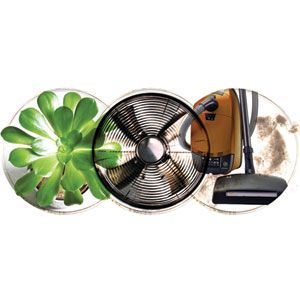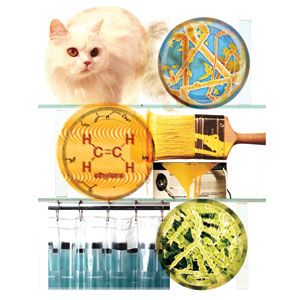
Like a Ghostbuster, Bud Offermann shows up in people’s houses to exorcise the not-so-benign demons that lurk within. But rather than green, gooey ghouls, his targets are invisible contaminants, like dust mites, mold spores, or volatile organic compounds, that homeowners worry might be haunting their air and damaging their health.
“People come to me with all sorts of concerns,” says Offermann, president of San Francisco—based Indoor Environmental Engineering, an air-quality consulting firm. “They have small kids with allergies, or they are having symptoms themselves.” For $1,500, he conducts a complete air-quality checkup. If the complaint is a respiratory ailment, he checks for mold in bathrooms, kitchens, and air-handling systems. If nothing turns up, he’ll explore inside wall cavities and take air samples for laboratory analysis. Offermann’s more chemically sensitive clients sometimes call complaining of a generalized funk he terms “brain fog.” In those cases, he tests for volatile organic compounds (VOCs), chemical compounds that can be emitted by wall-to-wall carpet, finishes, plywood, and other construction materials.
“It’s kind of like detective work,” he says. And these days, Offermann is busier than Mike Hammer after a triple homicide. The Environmental Protection Agency estimates that the air inside our homes and offices is up to five times more polluted than even the smoggiest industrial town. In fact, as you sit reading this article in the comfort of your easy chair, you are likely sucking a miasma of bacteria, toxins, and allergens into your perfectly pink lungs. Asthma in children, who inhale 50 percent more air per pound of body weight than adults, has been directly linked to the presence of dust mites, mold, and pet dander. More formidable airborne enemies include radon, an invisible gas produced by uranium in the soil under your house; secondhand smoke; and poisonous gases like carbon monoxide, which can be emitted from poorly maintained gas stoves, furnaces, or fireplaces, and can cause headaches, chest pains, even death.

The White Glove Test
But wait a second, you say. We’ve been inhaling this stuff for years. Why are we getting so sick all of a sudden? Much of it can be attributed to modern construction methods. In the name of energy efficiency, newer houses are extremely airtight, which cuts down on heating costs but also prevents a healthy exchange between stale indoor and fresh outdoor air. Add to that the fact that in this age of central air-conditioning, hardly anyone cracks open a window anymore.
Fortunately, there are things you can do to improve the quality of your indoor air, and they don’t all require a visit from a Hazmat-suited pro. Start by keeping your house clean. Regular vacuuming and dusting gets rid of dust mites, pet dander, and tracked-in allergens. A vacuum with a HEPA-filter traps smaller particles that other vacuums exhaust back into the air. Get a slipcover for your sofa, wash it frequently, and don’t let the dog up there, no matter how sad those big brown eyes look. In the bathroom, check the walls, shower curtain, and under the sink for mold and mildew, and wash towels and bath mats at least once a week. Inspect your kitchen for mold, too—especially under-sink cabinets and the refrigerator drip tray—and make sure cleaning products are well sealed, because they can leak VOCs.
When not properly maintained, HVAC systems can become breeding grounds for mold. “In most buildings and homes, the air handlers just aren’t kept up,” says Bill Eva, a senior industrial hygienist with an air-quality consulting company in Clearwater, Florida. “People don’t realize how important it is to keep them clean.” Eva recommends changing filters and cleaning coils regularly.
To combat carbon monoxide, shell out $30 for a detector. If readings are above 10 parts per million, get on the horn to your utility company, as your furnace or gas stove might be damaged or working improperly. You can also pick up a radon testing kit at your local hardware store for about $35. If the gas is present, you might need to seal up cracks in your foundation to stop it from seeping through.
Whole-house and Portable Filtration
No matter how good a housekeeper you are, it’s impossible to eliminate all airborne contaminants. But you can control them with proper ventilation. Make sure the vent fans in your kitchen, bathroom, and laundry room are working properly; if you don’t have any, think about installing them. You can also increase air exchange by putting in an attic fan to suck stale air out and pull fresh outside air in, or investing in an energy recovery ventilator (ERV), a device that uses ducts to distribute fresh air throughout the house.
Whole-house or portable air filters from companies such as Trane, AprilAire, or Carrier are another good option. At the very least, replace the existing flat filter in your forced-air system with a more efficient pleated one. The best ones are are electrostatically charged and can trap allergens like pet dander and pollen, which can pass through conventional filters. More elaborate “media filters” are boxy units containing 8-inch-thick blocks of filtration material. These require professional installation, since ductwork has to be cut to accommodate them. Portable air cleaners with HEPA filters are good for individual rooms. But according to Offermann, all of this air-cleaning technology can only do so much to keep you breathing easy. “If you don’t keep your house clean,” he says, “even the best filters are pretty much useless.”

